Oikean puulajin valinta kitaraasi varten

Akustisissa kitaroissa käytettävät puulajit ja niiden ainutlaatuiset sointiprofiilit
Räätälöidyissä akustisissa kitaroissa yksi tärkeimmistä päätöksistä on käytettävä puulaji. Erilaisilla puilla, eli “sointipuilla”, on ainutlaatuisia soinnillisia ominaisuuksia, ulkonäköä ja muita piirteitä, jotka vaikuttavat merkittävästi kitaran ääneen ja soittotuntumaan. Tässä on opas yleisimmistä akustisissa kitaroissa käytetyistä puulajeista ja siitä, mitä ne tarjoavat sointiprofiilin ja soitettavuuden kannalta.
- Kuusi: Soittopintojen standardi
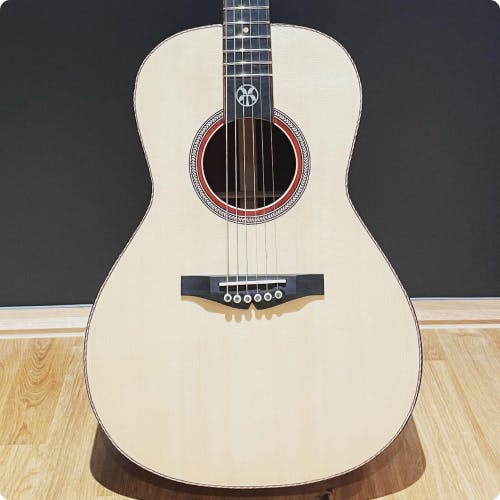
Ominaisuudet: Kuusi on yksi yleisimmin käytetyistä puulajeista akustisten kitaran kansissa, tunnettu keveydestään ja kestävyydestään. Se on suosittu selkeiden, kirkkaiden ja tasapainoisten sävyjen tuottajana.
• Sointiprofiili: Kuusi tarjoaa laajan dynaamisen alueen, joten se sopii monenlaisiin soitto- ja tyylilajeihin. Ääni on hyvin tasapainoinen, kirkas ja artikuloitu, ja se reagoi hyvin sekä strummaukseen että sormisoittoon.
• Suosittuja lajeja: Sitka-kuusi (monipuolisuutensa vuoksi yleisesti käytetty), Adirondack-kuusi (tunnettu voimakkaasta äänestä ja äänenvoimakkuudesta) ja Engelmann-kuusi (tarjoaa hieman lämpimämmän sävyn).
Kuusi on erinomainen valinta, jos haluat kitaran, jonka ääni on monipuolinen ja sointuu eri musiikkityyleihin ja soitto-tekniikoihin.
- Mahonki: Lämmin, täyteläinen ja fokusoitu
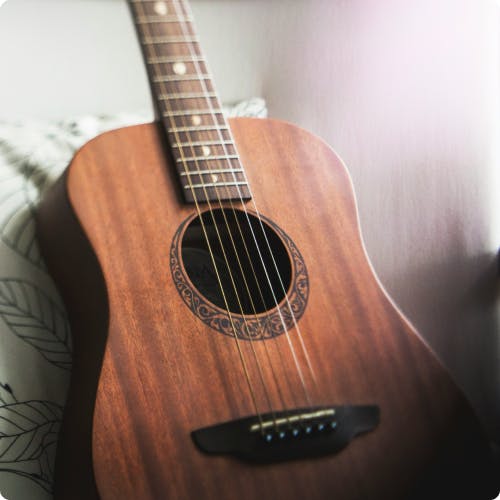
Ominaisuudet: Mahonki on tiheä ja kestävä kovapuulaji. Sitä käytetään yleisesti akustisten kitaroiden takana ja sivuilla, mutta joskus myös kitaran kansiosassa.
• Sointiprofiili: Mahonki tuottaa lämpimän, keskialueelle painottuvan sävyn, joka on täyteläinen ja maanläheinen. Sen äänessä on vahvat perussävyt, ja sen ylä-äänet ovat vähemmän monimutkaiset kuin monilla muilla puilla. Tämä sopii erityisesti blues-, folk- ja country-musiikkiin.
• Käyttökohteet: Mahonki-kansi luo lämpimän, puumaisen soinnin, kun taas mahongin takakansi ja sivut tarjoavat vahvan keskialueen ja lisäävät äänen syvyyttä.
Mahonki on erinomainen valinta muusikoille, jotka haluavat fokusoituneen, lämpimän äänen vahvalla keskialueella.
- Ruusupuu: Monimutkainen, resonanssirikas ja syvä
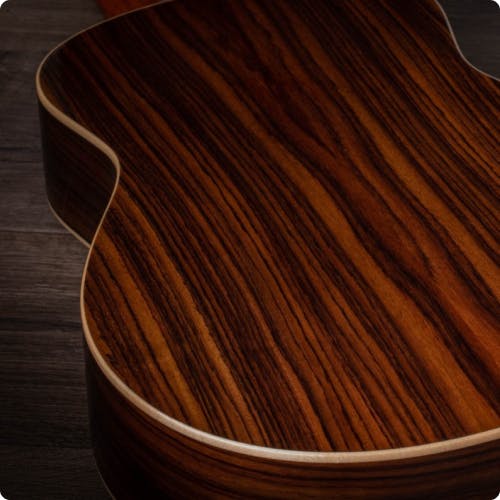
Ominaisuudet: Ruusupuu on yksi visuaalisesti näyttävimmistä sointipuista, usein tumman ja runsaan värinen monimutkaisilla syykuvioilla. Sitä käytetään tyypillisesti kitaran takana ja sivuilla.
• Sointiprofiili: Ruusupuu tunnetaan rikkaista ylääänistään ja monimutkaisesta resonanssistaan. Se tarjoaa syvän basson, kirkkaan diskantin ja korostetun keskialueen, mikä antaa täyteläisen äänen, joka sopii erityisesti sormisoittajille.
• Suosittuja lajeja: Intialainen ruusupuu on yleisin saatavuutensa ja sointinsa vuoksi, kun taas brasilialainen ruusupuu on harvinainen ja arvostettu poikkeuksellisesta resonanssistaan.
Ruusupuu on suosittu valinta kitaristeille, jotka etsivät runsasta, resonanssirikasta ääntä, jossa on tasapaino lämpimän ja kirkkaan välillä.
- Vaahtera: Selkeä, kirkas ja artikuloitu
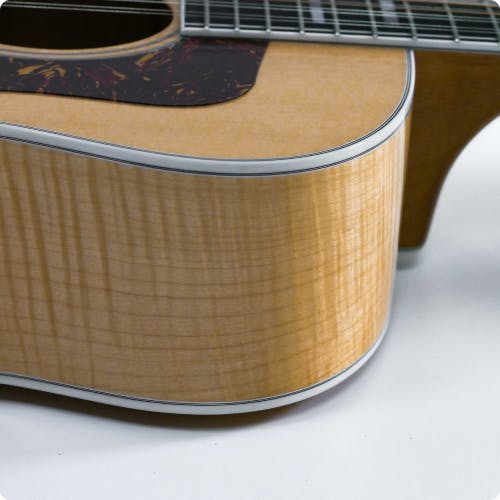
Ominaisuudet: Vaahtera on tiheä kovapuu, jolla on näyttävä ulkonäkö ja usein kauniita kuvioita, kuten liekki- tai peittokuvioita. Sitä käytetään yleisesti kitaran takana ja sivuilla.
• Sointiprofiili: Vaahtera tuottaa selkeän, kirkkaan ja artikuloidun äänen, jossa nuottien kesto on nopea. Sen yläsävelet eivät ole yhtä monimutkaiset kuin esimerkiksi ruusupuulla, mikä antaa kuivan ja fokusoidun soinnin, jossa jokainen nuotti erottuu selkeästi.
• Ihanteellinen käyttö: Vaahtera sopii hyvin yhtyeissä soittaville muusikoille, koska sen artikuloitu ääni erottuu miksauksessa häiritsemättä muita soittimia.
Vaahtera on erinomainen valinta, jos haet kitaraasi selkeyttä ja tarkkuutta, erityisesti live-esiintymisiin.
- Setri: Lämmin ja herkkä reagoinnissa
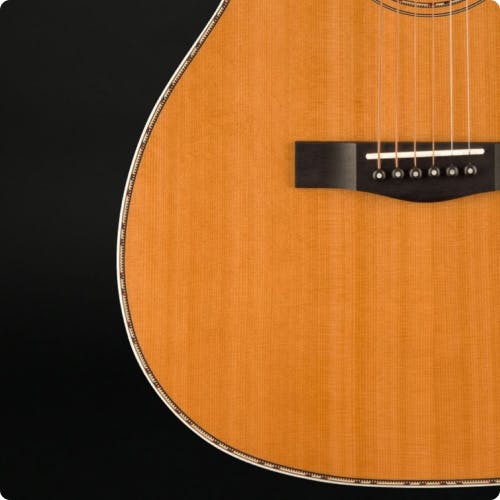
Ominaisuudet: Setri on pehmeämpi sointipuu, jota käytetään usein klassisten ja sormisoittokitaroiden kansina. Puulla on lämmin, tumma väri ja tasainen, sileä syykuvio.
• Sointiprofiili: Setri tuottaa lämpimän, täyteläisen äänen runsailla harmonisilla sävyillä, erityisesti matalammalla äänenvoimakkuudella. Se reagoi herkästi kevyisiin soittootteisiin, joten se sopii erinomaisesti sormisoittajille, jotka arvostavat hienovaraisia dynamiikkoja.
• Huomioitavaa: Setri on hieman pehmeämpää kuin kuusi, joten se ei kestä yhtä hyvin aggressiivista strummausta, mutta loistaa intiimissä ja nyansoidussa soitossa.
Setri on loistava valinta kitaristeille, jotka haluavat lämpimän ja täyteläisen äänen, erityisesti pehmeässä sormisoittomusiikissa.
- Koa: Tasapainoinen ja monipuolinen ainutlaatuisella ulkonäöllä
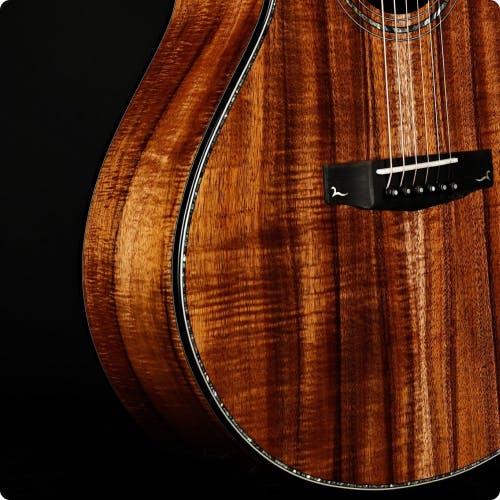
Ominaisuudet: Koa on trooppinen kovapuu, joka on kotoisin Hawaijilta. Se on arvostettu upeasta ulkonäöstään, jossa on usein ainutlaatuisia syykuvioita ja värejä kullanruskeasta tummanruskeaan.
• Sointiprofiili: Koalla on tasapainoinen sointiprofiili, joka sijoittuu ruusupuun ja mahongin välille. Aluksi ääni on kirkas ja selkeä, mutta ikääntyessään se avautuu lämpimämmäksi ja rikkaammaksi. Koa on monipuolinen ja reagoi hyvin sekä strummaukseen että sormisoittoon.
• Ihanteellinen käyttö: Koan monipuolisuus ja ulkonäkö tekevät siitä suositun valinnan kitaristeille, jotka haluavat ainutlaatuisen ja näyttävän soittimen, jonka ääni kehittyy ajan myötä.
Koa sopii erityisesti soittajille, jotka haluavat monipuolisen kitaran, joka ikääntyy kauniisti sekä soinniltaan että ulkonäöltään.
- Saksanpähkinä: Lämmin ja tasapainoinen
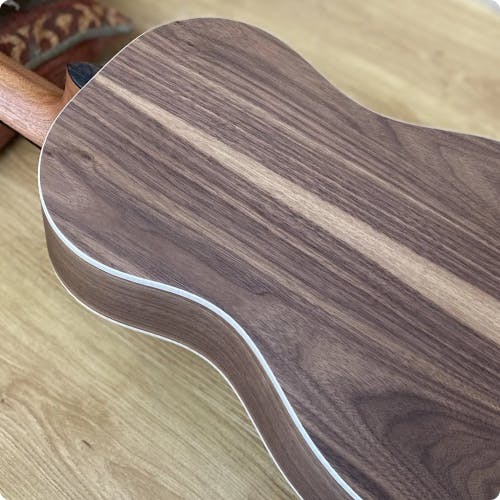
Ominaisuudet: Saksanpähkinä on keskitiheä kovapuu, jolla on tumma, maanläheinen ulkonäkö. Sitä käytetään usein akustisten kitaroiden takana ja sivuilla.
• Sointiprofiili: Saksanpähkinä tuottaa lämpimän, puumaisen äänen, joka rikastuu iän myötä. Sen sävyt sijoittuvat mahongin ja ruusupuun väliin, tarjoten tasapainoisen äänen, jossa on hieman korostunut keskialue.
• Monipuolisuus: Saksanpähkinä sopii hyvin sekä strummaukseen että sormisoittoon, joten se on varma valinta monenlaisiin musiikkityyleihin.
Saksanpähkinä on erinomainen vaihtoehto soittajille, jotka hakevat tasapainoista ääntä, joka lämpenee ajan myötä.
- Padouk: Resonanssirikas ja värikäs
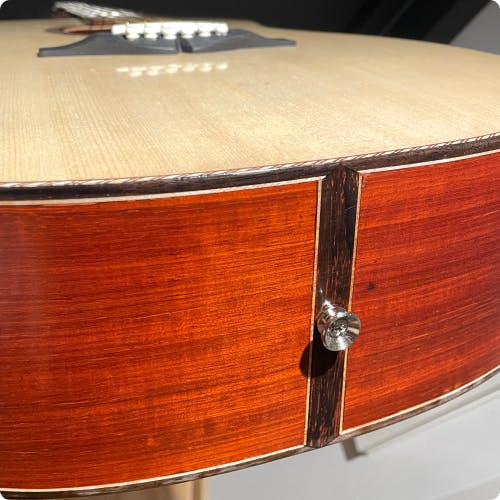
Ominaisuudet: Padouk on tiheä kovapuu, joka tunnetaan eloisasta punertavan oranssista väristään, joka tummuu ajan myötä rikkaaksi, tummanruskeaksi sävyksi. Sitä käytetään yleisesti kitaran takana ja sivuilla, ja se on arvostettu kestävyytensä ja ainutlaatuisen ulkonäkönsä vuoksi.
• Sointiprofiili: Padouk tuottaa vahvan, resonanssirikkaan äänen, jossa on korostunut basso ja kirkkaat, kirkkaat diskantit. Sen soinnissa on luonnollinen lämpö ja selkeys, tasapainoinen keskialue ja hieman terävämpi yläääni verrattuna ruusupuuhun.
• Monipuolisuus: Padoukin tasapainoinen ääniprofiili tekee siitä erinomaisen valinnan sekä strummaukseen että sormisoittoon. Se toimii hyvin eri tyylilajeissa, bluesista folk-musiikkiin, tarjoten täyteläisen ja monipuolisen äänen, joka täydentää erilaisia soitto-tyylejä.
Padouk on ihanteellinen vaihtoehto kitaristeille, jotka etsivät visuaalisesti näyttävää puuta voimakkaalla, resonanssirikkaalla äänellä. Sen omaleimainen sävy ja kestävyys tekevät siitä ainutlaatuisen valinnan, joka rikastuu iän myötä.
Oikean sointipuun valinta räätälöityyn kitaraasi
Puun valinnalla on syvä vaikutus räätälöidyn kitaran ääneen ja persoonallisuuteen. Jokainen sointipuu tuo mukanaan oman luonteensa, joten soitto-tyylin ja ääni- mieltymysten huomioiminen on tärkeää materiaalien valinnassa. Kun olet valmis rakentamaan räätälöidyn kitaran, autan sinua mielelläni valintaprosessissa varmistaaksesi, että soitimesi heijastaa ainutlaatuista tyyliäsi ja musiikillisia tarpeitasi.